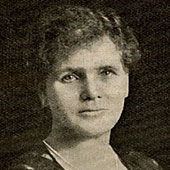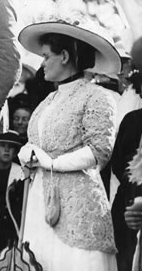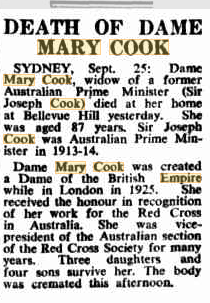
Vice President War Chest Society
President of the Red Cross Society Parramatta. (1863- Sept 1960)
Lady Mary Cook was born in Staffordshire, England in 1863. She came from a mining family where her brothers had left to work in the mine. Mary became a school teacher at Chesterton Girls’ School and by 1885 was assistant mistress there. It was that year at the age of twenty two that she married Joseph Cook. During that year the couple also decided to immigrate to Australia. And it was here that Joseph Cook began his political career and Mary her role with the Red Cross.
In 1891 Joseph had become a member of the New South Wales parliament and the he and Mary had three sons. In 1901 he was the Federal Member for Parramatta and the couple then had six children. Their time was spent separate as Joseph stayed in Melbourne for parliamentary sittings and Mary lived in their house in Lithgow New South Wales with their children. By 1906 they had nine children.
It was when the children were older and with the start of World War 1 that Mary began her work with the Red Cross and became Vice President of the War Chest Society and President of the Parramatta Branch of the Red Cross Society.
Members of the War Chest society met regularly to knit socks and make clothing to send to the front for the war effort. They also sent food packages. Members of the Red Cross Society were very active in Parramatta organising supplies and fundraising for the war effort. They assisted soldiers overseas and helped with their families back home as well.
Mary’s work with the Parramatta Red Cross started in 1915 and when she was made its president. Working with her daughter Mary Moxham with the wife of the Mayor, Mrs Graham, what was a sewing circle to start with was held at the Jubilee Hall.
At first Mary and her ladies had 11 sewing machines and by the end of a month they had had sent away 107 mosquito net, 100 pairs of knitted socks, 67 pairs of pyjamas, cholera belts, bandages and supplies such as soldiers’ kits to Red Cross headquarters. The work was done by many ladies and girls including students from Parramatta High School and Parramatta Convent and other local schools. Within a few years the Parramatta Red Cross sewing group had over 50 members and was producing close to 3100 items a month.
Mary kept on supporting and working with the Red Cross in Parramatta as well as overseas. She accompanied her husband in his role as Navy Minister and in 1918 Mary Cook attended events in London for the Imperial War Conference. While there Cooks visited their home towns in Staffordshire, with much fanfare.
During Joseph Cook’s term as High Commissioner, (1921-1927) Cook was specific given the role as High Commissioner to encourage immigration to Australia and bolster Australian produce and trade. Mary was in London for these six years and they were busy years. And again Mrs Cook again played a key role for the Australian Red Cross Society, and in 1923 she represented the Society at a meeting of the International Red Cross Board of Governors in Paris.
As the wife of the High Commissioner she saw to the organisation and assistance of many social and political gatherings. Attended to many Australians visiting London, as well as attending every public event and was interviewed and photographed at most of these. Mary took a particular interest in supporting British women who wanted to live in Australia, Australian produce and promoted cooking as a benefit for the Empire. In particular saying that the “popularisation of Australian dried fruits as light refreshments would be a real service to the empire.” Suggesting that “raisins and sultana’s between bread and butter make delightful sandwiches for at home, tennis teas and bridge parties.”
Mary was awarded the Dame of the Order of the British Empire in 1925 for her work with the Red Cross since 1915. The couple returned to Australia in 1927 leaving political life. Mary had an active retirement working with Newington College to help raise funds for the school’s students and facilities.
Joseph Cook died in 1947 and Mary death was then three years later in 1950 at her home in Bellevue Hill.
References.
RED CROSS WORK (1915, June 20). The Sun (Sydney, NSW : 1910 – 1954), , p. 21. http://nla.gov.au/nla.news-article229316763
Parramatta High School (1918, October 2).The Cumberland Argus and Fruitgrowers Advocate (Parramatta, NSW : 1888 – 1950), , p. 3. http://nla.gov.au/nla.news-page9098242
Parramatta Red Cross Branch. (1915, October 20). The Cumberland Argus and Fruitgrowers Advocate (Parramatta, NSW : 1888 – 1950), , p. 3. http://nla.gov.au/nla.news-article86094702
For the Red Cross. (1915, April 7). The Cumberland Argus and Fruitgrowers Advocate (Parramatta, NSW : 1888 – 1950), , p. 3. http://nla.gov.au/nla.news-article86097505
DAME MARY COOK DEAD (1950, September 26). Lithgow Mercury (NSW : 1898 – 1954), p. 2 http://nla.gov.au/nla.news-article219766283
https://en.wikipedia.org/wiki/Dame_Mary_Cook#References
http://primeministers.naa.gov.au/primeministers/cook/spouse.aspx
“AT HOME” TO DAME MARY COOK. (1928, September 1). Chronicle (Adelaide, SA : 1895 – 1954), , p. 73. http://nla.gov.au/nla.news-article90046256
THE PARRAMATTA PATRIOTIC FUND. (1914, August 22). The Cumberland Argus and Fruitgrowers Advocate (Parramatta, NSW : 1888 – 1950), , p. 12 http://nla.gov.au/nla.news-article85965083
THE WAR. (1914, August 22). The Cumberland Argus and Fruitgrowers Advocate (Parramatta, NSW : 1888 – 1950), , p. 12. http://nla.gov.au/nla.news-article85965046
VERY NICE, TOO (1926, August 16). The Sun (Sydney, NSW : 1910 – 1954), , p. 11 http://nla.gov.au/nla.news-article222712830
DEATH OF DAME MARY COOK (1950, September 26). The West Australian (Perth, WA : 1879 – 1954) http://nla.gov.au/nla.news-article47888706
Mrs Prime Minister, PublicImage, Private Lives. Picture of Mary Cook. http://mrspm.moadoph.gov.au/timeline.html
Emma Stockburn, Research Facilitator, Parramatta Heritage Centre, City of Parramatta, 2016.




